Grumman F3F The Last Navy Biplane
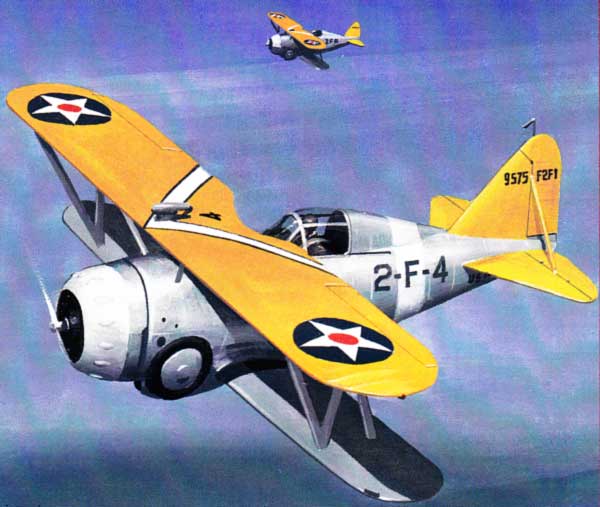
A natural development of the FF1 two-seat naval fighter of 1931, which Grumman proposed, was a single-seat fighter, the F2F, in 1932. The larger F3F followed in 1934 and this was destined to be the last biplane fighter ordered by the Navy for deliver in 1937-38. These tubby biplanes, with their characteristic retractable landing gear (a Grumman patented design), were to keep the biplane era alive in the American fleet until 1940.
Grumman F3F
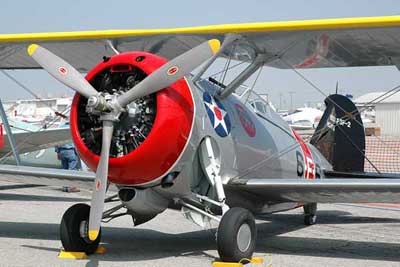
The performance of Grumman's F2F-1 was clouded only by the poor directional stability and spinning characteristics caused by its short fuselage. While the Navy felt the F2F- 1 was an excellent fighter in the other aspects which determine the value of such a machine, they also believed the design could be refined to correct its deficiencies. Even before the first production F2F- I was scheduled for completion, the Navy awarded Grumman a development contract for its successor, the XF3F-1.
Increasing the length and span were considered the most important steps toward correcting the stability problems. The fuselage of the XF3F-1 was stretched 22 inches beyond that of the F2F-1, and the wings were expanded three and a half feet, adding 3l square feet to the overall area. Although the extensions tended to give a slimmer appearance, there was no doubt about its heritage. The powerplant was a 700 hp Pratt & Whitney R-1535-72, the same type being installed in the F2F-1's on the production line.
The prototype XF3F-1 was comPleted and ready for its first flight on March 20, 1935, and three flights were completed that morning. Again, Grumman was certain they had a winner. Two days later, the XF3F-1 was subjected to the mandatory terminal velocity dives. Ten dives had been scheduled and the first nine were completed without mishap. On the tenth plunge, however, it appeared that the pilot pulled the nose up too abruptly causing the over-stressed fighter to disintegrate and tumble to the ground. The Navy immediately ordered a replacement and the second XF3F-1, bearing the same BuNo as the original, #9127, was completed in two months and flew on May 9, 1935.
Misfortune struck again two days later when the second prototype failed to recover from a spin during a demonstration for the Navy. This time, however, the pilot successfully abandoned the stricken plane and parachuted to safety. The pilot's report indicated that high speeds induced directional instability. This caused the XF3F-1 to enter a flat spin from which recovery was impossible.
Now that the problem was known, the Navy ordered yet a third XF3F-1 again with the same bureau number-and this one continued the test program on June 20, 1935. Some parts of the second prototype had been salvaged and were incorporated into the third ship, hence the short construction time. The Navy accepted the XF3F-1 on August 1, and three days later ordered 54 F3F-1's.
The production F3F-1's had a small fin like extension on the empennage for increased area. These planes used Pratt & Whitney R-1535-84 engines with a normal rating of 650 hp, but delivering 700 hp for take-off. Their gross weight was nearly 100 pounds more than that of the prototype, but with a speed of 231 mph at 7,100 feet, they were 5 mph faster than the XF3F-1. This was the same as the maximum speed of the F2F- 1.
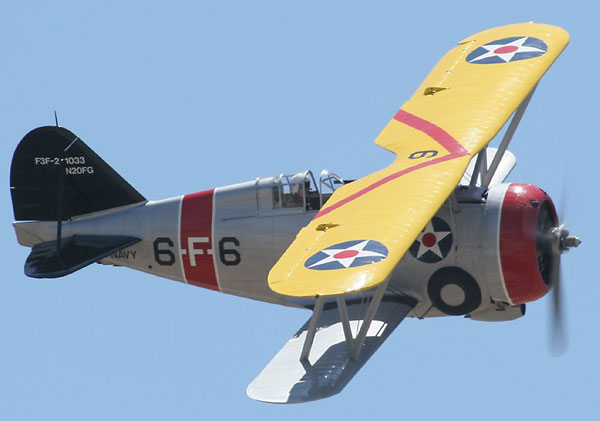
The controls of the F3F- 1 were extremely sensitive and maneuverability was far better than the F2F. The F3F still had a dangerous spin, but would respond well if the pilot treated it properly. For safety though, intentional spins were prohibited. During the first four months of operations a structural weakness caused four of the fighters to crash. A reinforcing of the upper wing spars and aileron controls solved the problem and the planes were returned to service with their Navy and Marine squadrons.
Though the Navy could no longer dispute the fact the biplane was a lost cause, they still clung to the hope that, at least while the monoplane was being perfected, they could have a two-winged fighter of comparable performance. Since Grumman had been able to improve upon the F2F, they were asked to perform a similar task on the new ship. On March 6, 1936, Grumman received a contract for their fourth biplane fighter design, the XF4F-1. This one was to utilize an experimental Wright XR-1670 engine. Grumman suggested that the performance sought from the new design might be achieved by installing a supercharged 750 hp Wright R- 1820-22 on the F3F. The engineering effort could then be directed toward developing the F4F as a monoplane. Grumman had already begun such a conversion and the Navy took this alternative un- der consideration. The Navy agreed to the proposal and a contract was approved for the XF3F-2 on July 28, 1936 one day after the modified plane was delivered to Anacostia.
The single-row Wright engine was larger in diameter than the Pratt & Whitney and necessitated a revision to the cowling. To absorb the increased power, a three-bladed controllable pitch propeller was mounted to the shaft while the rudder was enlarged to counter the added torque. Due to problems with the carburetor system for the supercharged engine, flight testing was delayed until January 1937.
Grumman's estimates of improved performance were borne out when the results of the flight tests were evaluated. With the super-charged Wright turning out 850 hp at 5,800 feet, the XF3F-2 reached a speed of 255 mph and the service ceiling was raised by 4,000 feet. This merited the award of a contract for 81 examples, the largest order yet received by Grumman. A few minor problems delayed the squadron deliveries, but the first planes began filling the ranks by December 1, 1937.
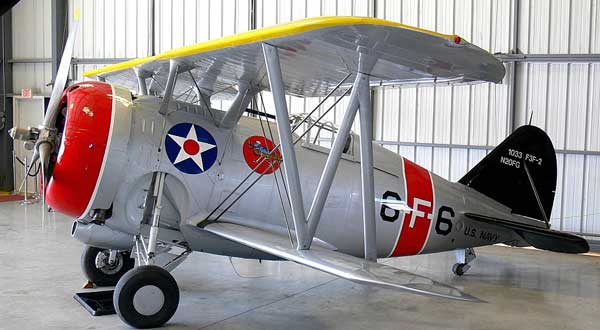
Development time for the new monoplanes was delaying their anticipated delivery; and by mid-1938 the Navy had planned to add another fighting squadron to the fleet. It was clear that new planes had to be obtained for this expansion, and the Navy was becoming quite concerned about the source of these machines when Grumman once again suggested upgrading the F3F. This time, one of the fighters was sent to the Langley wind tunnel to determine what additional refinements could be made. The resulting F3F-3 had a smaller diameter propeller, modified cowling, a cockpit canopy of the type proposed for the F4F, and a contract for 27 examPles. The final F3F version had a maximum speed of 264 mph and a normal gross weight of 4,543 pounds. Landing speed was 68 mph. It is rather interesting to note that at this point, the landing speed of the later biplanes, in the range of 60-70 mPh, was not appreciably slower than the "unacceptable" approach speeds of the new monoplanes.
Dimensions of the F3F series differed only slightly. Wingspan was the same on all versions- 32 feet with an area of 206 square feet. The F3F-1 was 23 feet 3 inches long, the -2 and -3 were 23 feet even. The F3F-1 was 9 feet 1 inch high while the -2 and -3 were 9 feet 4 inches.
The entire series carried armament of one .50 and one .30 cal. Browning machine guns in the cowl with 200 rounds for the .50 and 500 rounds for the .30.
The last F3F, a -2 model, was retired from flying in November, 1943, ending almost a decade of service for the Grumman single-seat biplane fighters.
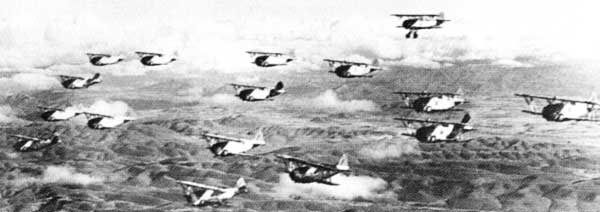
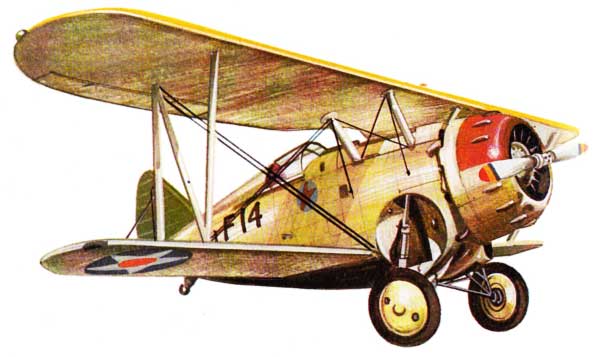
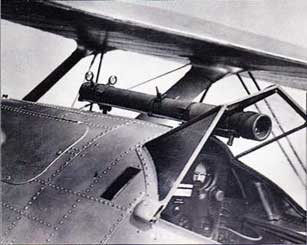 |
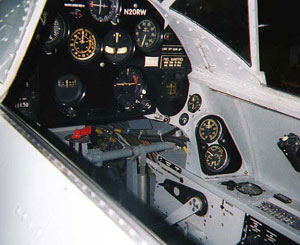 |
The Telescopic Gunsight of the Grumman F3F. |
Cockpit of the Grumman F3F. |
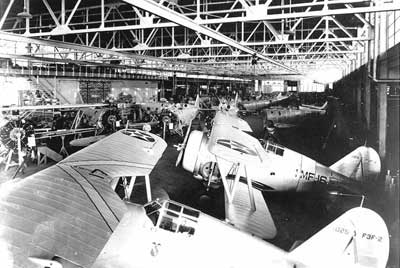 |
The Grumman F3F Factory. |
Specifications for the Grumman F3F
 |
Length: 23 ft 2 in Wingspan: 32 ft Height: 9 ft 4 in Wing area: 260 ft² Empty weight: 3,285 lb Max takeoff weight: 4,795 lb Powerplant: 1× Wright R-1820-22 "Cyclone" 9-cylinder radial engine, 950 hp Performance Maximum speed: 264 mph at 15,250 ft Cruise speed: 150 mph Range: 980 mi Service ceiling: 33,200 ft Rate of climb: 2,800 ft/min at sea level Armament Guns: 1× 0.30 in (7.62 mm) M1919 machine gun, 500 rounds (left) 1× 0.50 in (12.7 mm) M2 machine gun, 200 rounds (right) Bombs: 2× 116 lb Mk IV bombs, one under each wing |
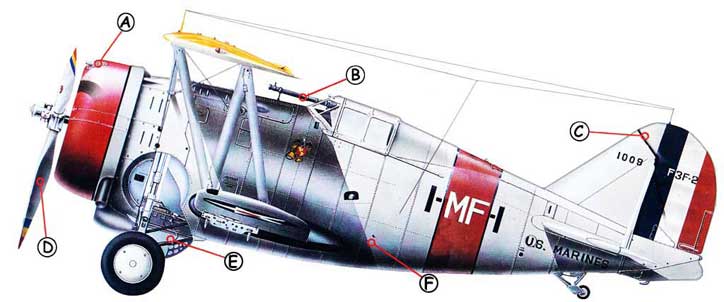 |
||
| A: Two .30 caliber (7.62-mm) Browning machine guns were mounted forward of the cockpit and fired through the propeller arc. | B: The tube ahead of the pilots windscreen is a Mark III Mod 4 telescopic gunsight. | C: Compared to the F2F, the F3F had 1 ft. 7 in. longer fuselage. wingspan increased by 3 ft. 6 in. and a slightly bigger tail unit than the earlier F2F. Improved handling was the goal. |
| D: F3F-2s used the 950-hp. Wright R-1820-22 Cyclone nine-cylinder single-row radial air-cooled engine. | E: Grumman's patented undercarriage had the main wheels retracting into the fuselage behind the engine. | F: Watertight compartments in the lower fuselage provided flotation in an emergency water landing. |
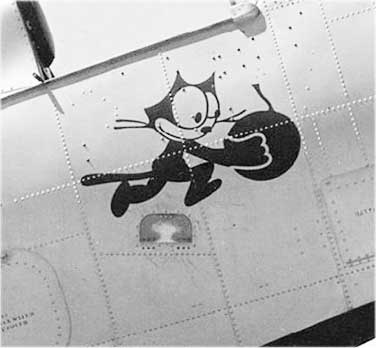 |
Grumman F3F before the crash. |
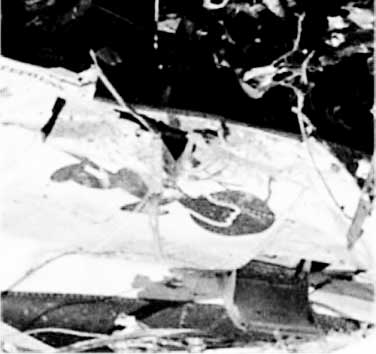 |
Grumman F3F after the crash. |

